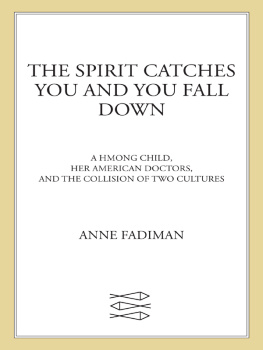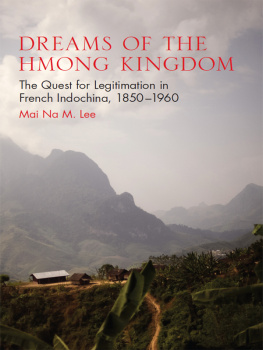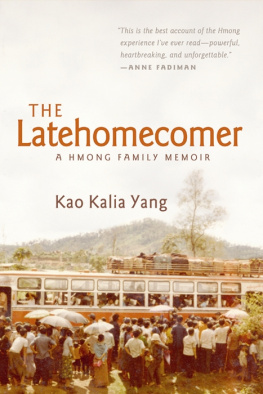Praise for
The Spirit Catches You and You Fall Down
Fadiman describes with extraordinary skill the colliding worlds of Western medicine and Hmong culture.
The New Yorker
This fine book recounts a poignant tragedyIt has no heroes or villains, but it has an abundance of innocent suffering, and it most certainly does have a moral[A] sad, excellent book.
Melvin Konner, The New York Times Book Review
An intriguing, spirit-lifting, extraordinary exploration of two cultures in uneasy coexistenceA wonderful aspect of Fadimans book is her even-handed, detailed presentation of these disparate cultures and divergent viewsnot with cool, dispassionate fairness but rather with a warm, involved interest that sees and embraces both sides of each issueSuperb, informal cultural anthropologyeye-opening, readable, utterly engaging.
Carole Horn, The Washington Post Book World
This is a book that should be deeply disturbing to anyone who has given so much as a moments thought to the state of American medicine. But it is much morePeople are presented as [Fadiman] saw them, in their humility and their frailtyand their nobility.
Sherwin B. Nuland, The New Republic
Anne Fadimans phenomenal first book, The Spirit Catches You and You Fall Down , brings to life the enduring power of parental love in an impoverished refugee family struggling to protect their seriously ill infant daughter and ancient spiritual traditions from the tyranny of welfare bureaucrats and intolerant medical technocrats.
Al Santoli, The Washington Times
A unique anthropological study of American society.
Louise Steinman, Los Angeles Times
Some writershave done exceedingly well at taking in one or another human scene, then conveying it to othersJames Agee, for instanceand George OrwellIt is in such company that Anne Fadimans writing belongs.
Robert Coles, Commonweal
When the Lees hedged their bets in 1982 in Merced by taking Lia to the hospital after one of her seizures, everybody lost. Fadimans account of why Lia failed to benefit over the years from Western medicine is a compelling story told in achingly beautiful prose.
Steve Weinberg, Chicago Tribune
A deeply humane anthropological document written with the grace of a lyric and the suspense of a thriller.
Abby Frucht, Newsday
Fadimans meticulously researched nonfiction book exudes passion and humanity without casting a disparaging eye at either the immigrant parents, who dont speak English, or the frustrated doctors who cant decipher the babys symptoms The Spirit Catches You and You Fall Down conveys one familys story in a balanced, compelling way.
Jae-Ha Kim, The Cleveland Plain Dealer
Fadimans sensitive reporting explores a vast cultural gap.
People Magazine
Compellingly written, from the heart and from the trenches. I couldnt wait to finish it, then reread it and ponder it again. It is a powerful case study of a medical tragedy.
David H. Mark, Journal of the American Medical Association
The Spirit Catches You and You Fall Down is Fadimans haunting account, written over a nine-year period, of one very sick girl in Merced, CaliforniaWhat happens to Lia Lee is both enlightening and deeply disturbing.
Kristin Van Ogtrop, Vogue
Fadiman gives us a narrative as compelling as any thriller, a work populated by the large cast of characters who fall in love with Lia. This is a work of passionate advocacy, urging our medical establishment to consider how their immigrant patients conceptualize health and disease. This astonishing book helps us better understand our own culture even as we learn about anotherand changes our deepest beliefs about the mysterious relationship between body and soul.
Elle
The other day, I picked up a book I had no intention of buying. Eight hours later, having lifted my head only long enough to pay for the book and drive home, I closed Anne Fadimans The Spirit Catches You and You Fall Down and started calling friendsThis is an important book.
Wanda A. Adams, The Honolulu Advertiser

Contents

Preface
Under my desk I keep a large carton of cassette tapes. Even though they have all been transcribed, I still like to listen to them from time to time.
Some of them are quiet and easily understood. They are filled with the voices of American doctors, interrupted only occasionally by the clink of a coffee cup or the beep of a pager. The rest of the tapesmore than half of themare very noisy. They are filled with the voices of the Lees, a family of Hmong refugees from Laos who came to the United States in 1980. Against a background of babies crying, children playing, doors slamming, dishes clattering, a television yammering, and an air conditioner wheezing, I can hear the mothers voice, by turns breathy, nasal, gargly, or humlike as it slides up and down the Hmong languages eight tones; the fathers voice, louder and slower and more vehement; and my interpreters voice, mediating in Hmong and English, low and deferential in each language. The hubbub summons a whoosh of sense-memories: the coolness of the red metal folding chair, reserved for guests, that was always set up as soon as I arrived in the apartment; the shadows cast by the amulet that hung from the ceiling and swung in the breeze on its length of grocers twine; the tastes of Hmong food, from the best ( quav ntsuas , congealed raw pigs blood).
I sat on the Lees red folding chair for the first time on May 19, 1988. Earlier that spring I had come to Merced, California, where they lived, because I had heard that there were some strange misunderstandings going on at the county hospital between its Hmong patients and its medical staff. One doctor called them collisions, which made it sound as if two different kinds of people had rammed into each other, head on, to the accompaniment of squealing brakes and breaking glass. As it turned out, the encounters were messy but rarely frontal. Both sides were wounded, but neither side seemed to know what had hit it or how to avoid another crash.
I have always felt that the action most worth watching is not at the center of things but where edges meet. I like shorelines, weather fronts, international borders. There are interesting frictions and incongruities in these places, and often, if you stand at the point of tangency, you can see both sides better than if you were in the middle of either one. This is especially true, I think, when the apposition is cultural. When I first came to Merced, I hoped that the culture of American medicine, about which I knew a little, and the culture of the Hmong, about which I knew nothing, would in some way illuminate each other if I could position myself between the two and manage not to get caught in the cross fire.
Nine years ago, that was all theory. After I heard about the Lees daughter Lia, whose case had occasioned some of the worst strife the Merced hospital had ever seen, and after I got to know her family and her doctors, and after I realized how much I liked both sides and how hard it was to lay the blame at anyones door (though God knows I tried), I stopped parsing the situation in such linear terms, which meant that without intending to, I had started to think a little less like an American and a little more like a Hmong. By chance, during the years I worked on this book, my husband, my father, my daughter, and I all experienced serious illnesses, and, like the Lees, I found myself spending a lot of time in hospitals. I passed many hours in waiting rooms gnawing on the question, What is a good doctor? During the same period, my two children were born, and I found myself often asking a second question that is also germane to the Lees story: What is a good parent?







![Yang - The latehomecomer: [a Hmong family memoir]](/uploads/posts/book/165016/thumbs/yang-the-latehomecomer-a-hmong-family-memoir.jpg)






